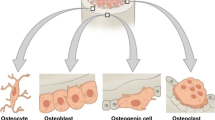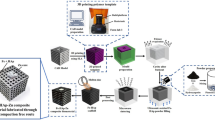Abstract
In this study, the scaffolds based on mineralized silver-loaded coral hydroxyapatites (SLCHAs) were developed for bone regeneration in the radius of rabbit with a 15-mm infective segmental defect model for the first time. The SLCHAs were achieved by surface adsorption and ion-exchange reaction between Ca2+ of coral hydroxyapatite (CHA) and Ag+ of silver nitrate with different concentration at room temperature. Release experiment in vitro, X-ray diffraction and scanning electron microscopy equipped with energy-dispersive X-ray spectrometer were applied to exhibit that the scaffold showed some features of natural bone both in main component and hierarchical microstructure. The three-dimensional porous scaffold materials imitate the microstructure of cancellous bone. Mouse embryonic pre-osteoblast cells (MC3T3-E1) were used to investigate the cytocompatibility of SLCHAs, CHA and pure coral. Cell activity were studied with alkaline phosphataseenzyme assay after 2, 4, 6 days of incubation. It was no statistically significant differences in cell activity on the scaffolds of Ag+(13.6 μg/mL)/CHA, Ag+(1.7 μg/mL)/CHA, CHA and pure coral. The results indicated that the lower silver concentration has little effect on cell activity. In the implantation test, the infective segmental defect repaired with SLCHAs was healed up after 10 weeks after surgery, and the implanted composites were almost substituted by new bone tissue, which were very comparable with the scaffold based on mineralized CHA. It could be concluded that the SLCHAs contained with appropriate silver ionic content could act as biocidal agents and maintain the advantages of mineralized CHA or coral, while avoiding potential bacteria-dangers and toxical heavy-metal reaction. All the above results showed that the SLCHAs with anti-infective would be as a promising scaffold material, which whould be widely applied into the clinical for bone regeneration.








Similar content being viewed by others
References
Foo LS, Hardes J, Henrichs M, Ahrens H, Gosheger G, Streitbürger A. Surgical difficulties encountered with use of modular endoprosthesis for limb preserving salvage of failed allograft reconstruction after malignant tumor resection. J Arthroplasty. 2011;26:744.
Garcia-Cimbrelo E, Garcia-Rey E, Cruz-Pardos A. The extent of the bone defect affects the outcome of femoral reconstruction in revision surgery with impacted bone grafting: a 5–17-year follow-up study. J Bone Joint Surg Br. 2011;93:1457.
Paderni S, Terzi S, Amendola L. Major bone defect treatment with an osteoconductive bone substitute. Chir Organi Mov. 2009;93:89.
Steinlechner CW, Mkandawire NC. Non-vascularised fibular transfer in the management of defects of long bones after sequestrectomy in children. J Bone Joint Surg Br. 2005;87:1259.
DeCoster TA, Gehlert RJ, Mikola EA, Pirela-Cruz MA. Management of posttraumatic segmental bone defects. J Am Acad Orthop Surg. 2004;12:28.
Raucci MG, D’Antò V, Guarino V, Sardella E, Zeppetelli S, Favia P, Ambrosio L. Biomineralized porous composite scaffolds prepared by chemical synthesis for bone tissue regeneration. Acta Biomater. 2010;6:4090.
Giannoudis PV, Chris Arts JJ, Schmidmaier G, Larsson S. What should be the characteristics of the ideal bone graft substitute? Injury. 2011;42:S1.
Khaled EG, Saleh M, Hindocha S, Griffin M, Khan WS. Tissue engineering for bone production- stem cells, gene therapy and scaffolds. Open Orthop J. 2011;5:289.
Rohanizadeh R, Chung K. Hydroxyapatite as a carrier for bone morphogenetic protein. J Oral Implantol. 2011;37:659.
Mishra S, Rajyalakshmi A, Balasubramanian K. Compositional dependence of hematopoietic stem cells expansion on bioceramic composite scaffolds for bone tissue engineering. J Biomed Mater Res A. 2012;100:2483.
He J, Huang T, Gan L, Zhou Z, Jiang B, Wu Y, Wu F, Gu Z. Collagen-infiltrated porous hydroxyapatite coating and its osteogenic properties: in vitro and in vivo study. J Biomed Mater Res A. 2012;100:1706.
Lee JH, Yu CH, Yang JJ, Baek HR, Lee KM, Koo TY, Chang BS, Lee CK. Comparative study of fusion rate induced by different dosages of Escherichia coli-derived recombinant human bone morphogenetic protein-2 using hydroxyapatite carrier. Spine J. 2012;12:239.
Seeherman HJ, Azari K, Bidic S, Rogers L, Li XJ, Hollinger OJ, Wozney JM. rhBMP-2 delivered in a calcium phosphate cement accelerates bridging of critical-sized defects in rabbit radii. J Bone Joint Surg Am. 2006;88:1553.
Cai L, Wang Q, Gu C, Wu J, Wang J, Kang N, Hu J, Xie F, Yan L, Liu X, Cao Y, Xiao R. Vascular and micro-environmental influences on MSC-coral hydroxyapatite construct-based bone tissue engineering. Biomaterials. 2011;32:8497.
Figueiredo M, Henriques J, Martins G, Guerra F, Judas F, Figueiredo H. Physicochemical characterization of biomaterials commonly used in dentistry as bone substitutes–comparison with human bone. J Biomed Mater Res B. 2010;92:409.
Ripamonti U, Crooks J, Khoali L, Roden L. The induction of bone formation by coral-derived calcium carbonate/hydroxyapatite constructs. Biomaterials. 2009;30:1428.
Alexander JW. History of the medical use of silver. Surg Infect. 2009;10:289.
Lo SF, Hayter M, Chang CJ, Hu WY, Lee LL. A systematic review of silver-releasing dressings in the management of infected chronic wounds. J Clin Nurs. 2008;17:1973.
Ghani Y, Coathup MJ, Hing KA, Blunn GW. Development of a hydroxyapatite coating containing silver for the prevention of peri-prosthetic infection. J Orthop Res. 2012;30:356.
Vulpoi A, Gruian C, Vanea E, Baia L, Simon S, Steinhoff HJ, Göller G, Simon V. Bioactivity and protein attachment onto bioactive glasses containing silver nanoparticles. J Biomed Mater Res A. 2012;100:1179.
Paladini F, Pollini M, Talà A, Alifano P, Sannino A. Efficacy of silver treated catheters for haemodialysis in preventing bacterial adhesion. J Mater Sci Mater Med. 2012;23:1983.
Kowalczuk D, Ginalska G, Piersiak T, Miazga-Karska M. Prevention of biofilm formation on urinary catheters: comparison of the sparfloxacin-treated long-term antimicrobial catheters with silver-coated ones. J Biomed Mater Res B. 2012;100B:1874.
Zhang Y, Yin QS, Zhang Y, Xia H, Ai FZ, Jiao YP, Chen XQ. Determination of antibacterial properties and cytocompatibility of silver-loaded coral hydroxyapatite. J Mater Sci Mater Med. 2010;21:2453.
Ales H, Lenka J, Ludvik S. The influence of simulated body fluid composition on carbonated hydroxyapatite formation. Ceramics. 2002;46:9–14.
Oyane A, Onuma K, Ito A, Kim HM, Kokubo T, Nakamura T. Formation and growth of clusters in conventional and new kinds of simulated body fluids. J Biomed Mater Res. 2003;64A:339–48.
Vecchio KS, Zhang X, Massie JB, Wang M, Kim CW. Conversion of sea urchin spines to Mg-substituted tricalcium phosphate for bone implants. Acta Biomater. 2007;3:785.
Douglas T, Pamula E, Hauk D, Wiltfang J, Sivananthan S, Sherry E, Warnke PH. Porous polymer/hydroxyapatite scaffolds: characterization and biocompatibility investigations. J Mater Sci Mater Med. 2009;20:1909.
Guda T, Walker JA, Pollot BE, Appleford MR, Oh S, Ong JL, Wenke JC. In vivo performance of bilayer hydroxyapatite scaffolds for bone tissue regeneration in the rabbit radius. J Mater Sci Mater Med. 2011;22:647.
Acknowledgments
This work was in part supported financially by a grant from the program for Science and Technology Key of Guangdong Province (2003C104004 & 2004B33101005), Plan of 973 (2012CB619106) and twelfth five-year plan of military (CWS11C268) in China, the Guangdong Key Laboratory of Orthopaedic Technology and Implant Materials in China and the analysis foundation of Tsinghua University.
Author information
Authors and Affiliations
Corresponding authors
Rights and permissions
About this article
Cite this article
Zhang, Y., Yin, QS., Zhou, CS. et al. Osteogenic activity of silver-loaded coral hydroxyapatite and its investigation in vivo. J Mater Sci: Mater Med 25, 801–812 (2014). https://doi.org/10.1007/s10856-013-5115-y
Received:
Accepted:
Published:
Issue Date:
DOI: https://doi.org/10.1007/s10856-013-5115-y




